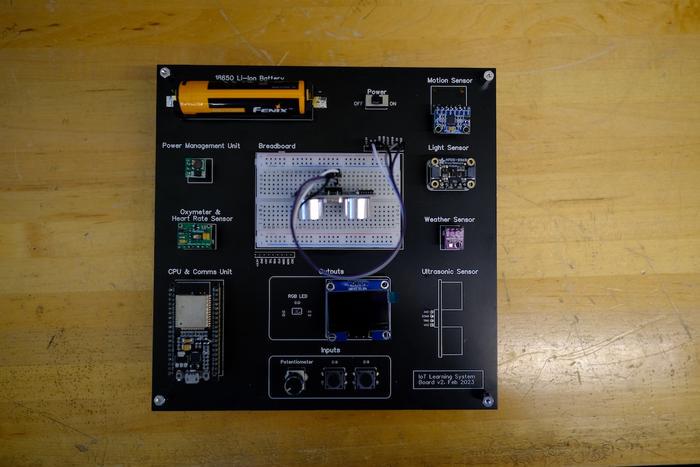High School Program Empowers Students to Code and Create Microelectronics for Artificial Intelligence Development
High School Program Empowers Students to Code and Create Microelectronics for Artificial Intelligence Development

LAWRENCE — In a groundbreaking initiative, public high school students across Kansas and two other states are poised to receive specialized training in the transformative field of artificial intelligence. This program aims to equip these young minds with the essential skills required to develop not only the software driving AI technologies but also the microelectronics that power them. As the United States intensifies its efforts to maintain global supremacy in microchip manufacturing and AI software development, this educational venture signifies a strategic pivot towards nurturing a skilled workforce for the future.
A collaboration involving researchers from the University of Kansas, the University of Florida, and the University of North Texas will allow around 500 students and 25 educators to embark on hands-on projects that enhance their understanding of technology, with the ultimate goal of nurturing a sustainable interest in computer science and engineering careers. This ambitious project is made possible through a substantial $1.4 million grant from the National Science Foundation, with the University of Kansas slated to receive approximately $350,000 to facilitate its own contributions to the program.
Leading this pioneering research at KU is Tamzidul Hoque, an assistant professor of electrical engineering and computer science. His team aims to establish a collaborative framework with local high schools, including Shawnee Mission West High School in Overland Park. Here, computer science educator Mark Lange will play a key role in implementing a curriculum designed to resonate with the interests and aspirations of high school students.
A cornerstone of the curriculum is the incorporation of Tiny Machine Learning (TinyML) devices—energy-efficient pieces of hardware capable of executing AI computations directly on-site without the need for cloud connectivity. This design aligns perfectly with the curriculum’s objectives of teaching students not merely to code but also to understand and manipulate the hardware that undergirds artificial intelligence applications.
Hoque articulates the importance of this innovative approach: “This will be a small device performing AI tasks at the user end without connecting to the cloud. TinyML represents a pivotal application enabling large AI models to be compacted into smaller versions that can run seamlessly on minimalistic hardware.” This philosophy underlines the intention to foster a practical understanding of how artificial intelligence can be integrated into everyday technologies.
Edge devices, as these systems are referred to, operate on their own microelectronics, liberating them from the constraints imposed by centralized data processing facilities. This decoupling fosters a greater diversity of applications while reinforcing the learning experience for students engaged in these projects. The significance of educating these future innovators about edge AI technologies cannot be overstated, as it serves not just to inspire interest in artificial intelligence but simultaneously cultivates skills in microelectronics—an essential area of knowledge in today’s tech landscape.
Hoque’s research team is dedicated to creating these edge devices specifically for classroom use, ensuring that they are adaptable to the evolving educational needs of students and educators alike. This endeavor is particularly urgent, as many high schools, especially those in economically disadvantaged communities, struggle with tight budgets that preclude the acquisition of high-tech learning tools. The planned hardware platform will integrate microprocessors, various sensors, and communication components, providing a multifaceted resource for hands-on learning in both software and hardware domains.
Moreover, affordability remains a critical challenge in this initiative. Hoque envisions a budget-friendly hardware platform, one that would cost less than $45 and be equipped with at least ten different sensors. Such a financial approach will make it feasible for schools with limited financial resources to engage students in high-tech education, thereby ensuring equitable access to these vital learning opportunities.
In addition to hands-on experience, part of the project focuses on evaluating the effectiveness of the curriculum and its delivery. Hoque and his team are committed to emphasizing community-oriented projects, ensuring students grasp the societal implications of their work. By instilling a sense of altruism and community responsibility within the engineering principles taught, educators hope to motivate students to think critically about how their technical skills can positively influence the world around them.
“We often focus on the lucrative aspects of careers when we discuss engineering pathways,” Hoque notes. “However, it is essential to highlight the role that engineering can play in fostering community betterment. Developing applications, such as technology for fire detection or agricultural innovations, enables students to see the societal value of their work, potentially igniting passion for fields that benefit others.”
This curriculum not only aims to empower students with sought-after technical skills but also positions them for future opportunities in high-paying fields related to AI and microelectronics. The strategic intention behind this initiative is to bolster Kansas’s potential to attract high-tech businesses by preparing a highly competent workforce that is capable of meeting industry demands.
Industry partners are also playing an instrumental role in shaping the curriculum to ensure that it stays aligned with current job market needs. An advisory board composed of industry professionals will provide valuable insights into the technical competencies and skills that are most relevant for prospective employees in the AI sector. This collaboration reflects a broader recognition of the importance of integrating industry expertise into educational frameworks to adequately prepare students for the realities of the tech workforce.
To further enhance this synergy between academia and industry, the researchers plan to facilitate conferences where high school teachers can exchange ideas with industry representatives on effective curriculum development and teaching methodologies. This collaborative effort aims to ensure that training remains industry-focused and directly responds to the evolving landscape of technology and workforce needs.
The impetus for this initiative is underscored by the CHIPS and Science Act, enacted by Congress in 2022, which seeks to bolster domestic semiconductor production while addressing national security concerns inherently tied to technological dependencies. Hoque highlights that the COVID-19 pandemic illuminated the vulnerabilities of relying on external supply chains, leading to increased governmental incentives for domestically manufactured microelectronics.
The broader implications of this project extend beyond mere technological training. The initiative seeks to inspire a new generation of engineers and innovators who are not only technically proficient but also cognizant of the social implications of their work. By fostering an educational environment that blends technical skill development with a strong sense of community responsibility, this project aims to cultivate a workforce that is prepared to tackle the complex challenges posed by the technological advancements of the 21st century.
As Kansas embarks on this ambitious educational journey, it stands as a testament to the importance of adapting educational practices to align with technological advancements and societal needs. This collaborative approach represents a crucial step toward equipping our youth with the skills necessary to thrive in the modern economy, ensuring that they are ready to contribute to a society that increasingly relies on innovative technologies to solve pressing problems.
—
Subject of Research: Training High School Students in AI and Microelectronics
Article Title: Kansas High School Students to Receive AI Training Amid Push for Domestic Tech Workforce
News Publication Date: [Insert Date]
Web References: [Insert URL]
References: [Insert relevant references]
Image Credits: Mahmudul Hasan
Keywords: Artificial Intelligence, Microelectronics, Education, Kansas, Workforce Development, Edge Devices, TinyML, National Science Foundation.
UMass Amherst Computer Scientist Honored with Prestigious ‘Nobel Prize of Computing’ for Pioneering Contributions to AI Technology
Next PostNew Discoveries Could Enhance Understanding of Maternal Infertility
3D Printed Teeth Enhance Dental Bridge Training







